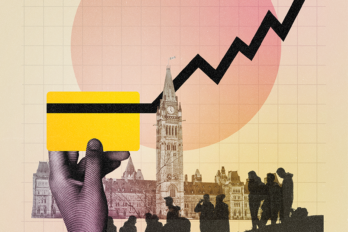The desk was tiny, wooden, and had no legs—it was meant to be screwed into a corner. When I was done using it, I could fold it flat against my bedroom wall and hide it behind my full-length mirror. In my ecstatic state buying it online, I may have even called it beautiful.
It was only the end of March and, a few weeks in, the pandemic already felt interminable. My partner and I were both working from the one-bedroom apartment we rent in Vancouver—I as a graduate student and teaching assistant, he as a journalist. I hadn’t opened a book or touched my thesis in weeks. I needed the proverbial room of one’s own, one with a door silencing my partner’s eating sounds and diaphragmatic work voice. I thought the desk would be my ticket back to normalcy via productivity.
I was wrong. I used the desk twice before deciding I hated it. If I wanted to work standing up for more than fifteen minutes without my feet hurting, I had to use a yoga mat. During virtual office hours with students, I realized my bed—covered in unfolded laundry—was in full view behind me. I’d planned to be efficient but was accidentally feeding into what I’d feared all along: that I’m a mess and that, if someone discovers this about me, I’ll have lost control of their perception.
As the pandemic spilled from weeks to months, I had ample time to analyze the other parts of my home that reminded me of my failings: my haphazard IKEA Stuk organizer, my bathroom cabinet overflowing with expired skin-serum samples and crusty lotion bottles, my credenza full of candle dregs and empty weed containers I don’t know if I can recycle.
I’d never thought about my home this much save for the days when we had friends over and I’d fastidiously organize every surface to project that I’m a tidy, functioning adult. But, now, I’m in a hamster wheel of panic as I try to make my home fit all of its new roles: an office and a gym, a classroom and a happy-hour cocktail lounge, a sanitary and comforting place to hide from the outside world.
I feel this anxiety in the panoptic way our workplaces now peer into our homes. I feel it in the Room Rater Twitter account, which playfully rates the decor behind those who video-call into TV interviews, or as I tinker with my so-called Credibility Bookcase. (I remember throwing my copy of The Ethical Slut out of view seconds before joining a work meeting.) Meanwhile, postsecondary students are subjected to online exam proctoring, which requires them to have extremely quiet, distraction-free rooms—unexpected noises or eye movements can cause them to be accused of cheating. The conditions of our work and education have changed, and our homes have to bend to fit them.
Listen to an audio version of this story
For more audio from The Walrus, subscribe to AMI-audio podcasts on iTunes.
On top of that, the internet makes a hyperefficient home feel like an accessible fantasy. Sunny Instagram and TikTok posts are replete with home makeover #goals, each a reminder that the key to a more livable pandemic is an easy DIY renovation away. Apartment Therapy’s website offers an endless scroll of efficiency-making inspiration while conspicuously dodging mention of the situation—a pandemic in which our productivity is being valued over our well-being—that makes it all necessary: “A 550-Square-Foot Apartment Masterfully Fits a Ton of Function in a Small Space”; “Before and After: A Closet-Turned-Office Makes Use of Every Inch—for Under $1000”; “10 Small-Space Dining Tables That Can Double as Work Desks.” The best space, it seems, is a utilized one.
It’s true that the way we arrange our homes can be a balm to the mass disorder of the world outside. A 2011 Princeton University study found that clutter prevents our brains from processing information efficiently (to which I say, “No kidding”). Organizing your fridge into oblivion is comforting in the same way it can soothe you to see your to-do list written on a piece of paper—it makes the task of living feel approachable. The drive to functionalize our homes is also routinely magnified by the uber-visual media we consume. But this drive does nothing to improve our experiences of actually being in the world during a deeply stressful time. At best, a well-organized home is a sign of the times, an idealized cure for the anxieties that ail us. At worst, it’s a bad cure for a bad world.
In August, Boston Magazine published an interview with architect Stephen Chung about the two-storey glass-walled structure he built on his property, complete with his home office on one floor and a space for his kids’ virtual school on another—a project, the magazine writes, that “may symbolize the COVID-inspired ingenuity we’ll see in the months and years to come.” Chung’s home is one of many optimistic examples of COVID-considerate architecture, designs for a world in which people spend more time at home. Australian architecture firm Woods Bagot, for example, has designed an apartment with a modular system of walls so residents can change the configuration of their home on the fly—an open-concept living room can be compartmentalized into a chic, Zoom-friendly office just by pushing some dividers around. Other building experts predict a future of more courtyards and balconies. When Boston asks Chung what he foresees, his answer is “mud rooms”—more designated places for people to take off their shoes and wash their hands. As I listen to a garbage truck squeal in the alley below my bedroom window for the fourth time this morning, the idea of having a mud room—any extra room, really—sounds quite nice.
Naturally, home renos are having a moment during the pandemic. Canadians are spending more on optimizing their living spaces than they were last year, such as converting unfinished basements into home gyms and offices or installing sound-proofing insulation to make working from home easier. To stimulate a lagging economy, the Newfoundland and Labrador government launched a $30 million residential-construction rebate program in June, allowing homeowners to claim 25 percent of the cost of renovations to their principal residences. But such projects are accessible only to those who own homes and have ample disposable income.
On one hand, I am very privileged. I make my living working from home, unlike many of my family and friends, who work riskier gigs in hospitals, clinics, and schools. On the other hand, people’s wealth—and their ability to use it to improve their situations—feels more vibrant and more dizzyingly taunting than ever.
If I could ask Marie Kondo any question, it would probably be: “Why do I still feel like shit?”
The answer, I think, requires a deeper understanding of the way homes function as guidelines for how we should live. Home design doesn’t just reflect the troubles and values of the times we’re in, like how the modern Bauhaus aesthetic of shiny, sanitary surfaces, open rooms, and large windows emerged in the aftermath of the Spanish flu. Home design also scripts how we, as humans, should embody these values.
This idea is central to Deborah Chambers’s Cultural Ideals of Home: The Social Dynamics of Domestic Space. Take nineteenth-century drawing rooms, where newly middle-class women flouted their emerging social mobility by repurposing household items as decor: turning drain pipes into vases or disembowelled pianos into tables. Male artists at the time lambasted what they saw as poor taste driving this creative use of space and resources. As Chambers points out, these men weren’t just saying that lower-class women shouldn’t be tastemakers—they were dog-whistling the century’s broader anxiety around upward mobility, issuing thinly veiled calls for the less affluent to stay in their lanes.
Or think of the sparkly optimism of “home of the future” displays from midcentury world fairs: model homes alongside installations often sponsored by companies’ futuristic technologies, like televisions and dishwashers. Events like the first New York World’s Fair, in 1939, were aimed at stimulating commerce and nationalism during the Great Depression. At the cusp of World War II, right before things fell apart, these fairs touted consumerism as a building block of a stable, democratic America.
A future historian may read the hyperorganized, hyperefficient home triumphs of COVID-19 in a similar way: that clean, aspirational images of the hyperfunctional home were a futile panacea for the chaos surrounding us.
The way home improvement is marketed to us, though, definitely makes it seem like we’re in control. It feels appropriate to admit something here: I’m really obsessed with IKEA. I’m addicted to the optimism of walking through the warehouse, giddy about all the things I am buying or will buy next time. Every time I visit, I dream about the person I’m on the precipice of becoming.
Several researchers, including Rania Magdi Fawzy, Per Ledin, and David Machin, have argued that this is exactly how IKEA is supposed to make me feel. According to these scholars, IKEA sees its customers as busy, self-enterprising people to whom its products offer a welcome respite. IKEA-catalogue quips like “In this kitchen, cooking is about slowing down, not stressing out” and “With floor-to-ceiling curtains, you decide when to let the world in” communicate not only that we are responsible for making our lives better but that we can buy and build “better” with our own hands. This ethos puts the burden of improvement on us instead of encouraging us to demand it from entities with more power and capital, like our governments and employers.
IKEA’s branding is distinct, yet the broader phenomenon is all around us. Capitalist ideals of maximizing value and pursuing independence have become the unassuming backdrops to the most intimate parts of our daily lives. I would even go as far as saying, as Lisa Duggan has, that this neoliberal language makes us a lot more game to participate in a system that helps the rich grow their wealth and power. We can chill out about the wealthy and happy getting wealthier and happier because we’re all potentially wealthy and happy—as long as we pull up our bootstraps and build the lives of our dreams, Allen keys in hand.
The catch: this constant project of bettering our homes in the shadow of global catastrophe feels, well, bad. And this seems to be the whole point. In order to work better, I spend more time tidying. I realize I need to buy more things to tidy better and work harder. I buy more things from IKEA, then become disappointed that the things from IKEA didn’t fix everything. I return to IKEA.
Making our homes work for us gives us a sense of control while we’re plagued by the capitalist grind (and by the actual plague of COVID-19). Both things have heightened my sense of guilt, even obsolescence. Witnessing my friends on the front lines break down under pressure, I wish I had more crucial skills beyond writing marketing copy and teaching creative writing.
So I take up home projects to imbue myself with a sense of purpose—the idea that, if I just buy the folding desk and drill it into my wall, I will finally have that big It (my life, my future) under control. I know I’m going to keep trying to find ways to optimize my home space because I don’t want to be left behind, perceived as lazy or unproductive. But there will always be something else outside of my control.
While I don’t want to cut myself too much slack, I will say that this is yet another script I’ve internalized. It’s more palatable to think we can eradicate COVID-19 by washing our hands (perhaps in a newly built mud room) and, relatedly, eliminate our pandemic ennui by diving into self- and home-improvement projects. But this does little to reckon with the deeper political and structural problems that have exacerbated the pandemic—like how discrimination has made it disproportionately difficult for racialized people to meet their financial obligations and needs, or how the Alberta government threatened to lay off up to 11,000 hospital cleaning and laboratory workers in October.
But, just because something feels normal, that doesn’t mean it’s the way it’s always been—or the way it always has to be. Imagine what could happen if we shifted the neoliberal targets off our backs, if only during the pandemic. Employers could compensate workers for using our homes as free corporate real estate. Governments could reject austerity in favour of more radical action to circuit-break the spread of the virus. We could provide better mutual aid by sharing excess resources with our neighbours instead of driving said resources into the next home reno (and the next, and the next).
Right now, though, it makes sense to feel like the plays we can manage with the hand we were dealt kind of suck.
I got a new desk, and the chair I’m sitting in to use it kind of sucks too: an IKEA one I found on Craigslist. It’s too low to sit comfortably at the new workspace. I’m trying not to resent it as much as I did the last one—although the desk, I’m pretty sure, was never really the problem.




